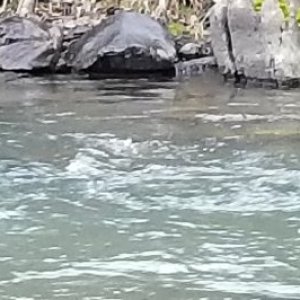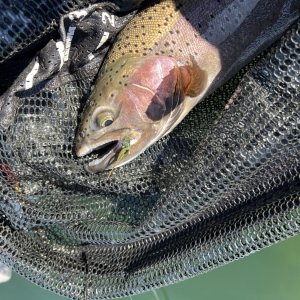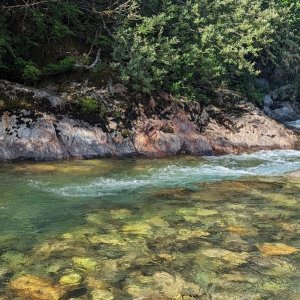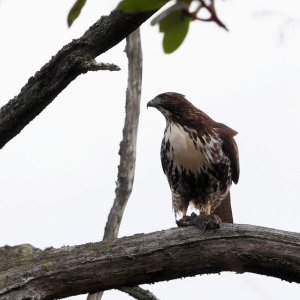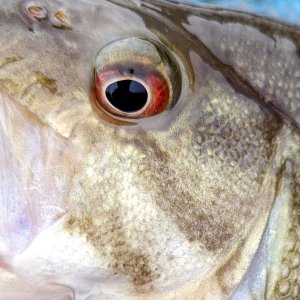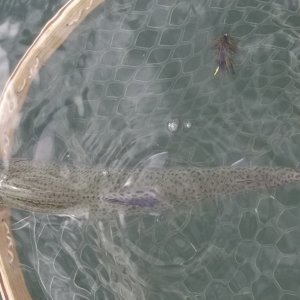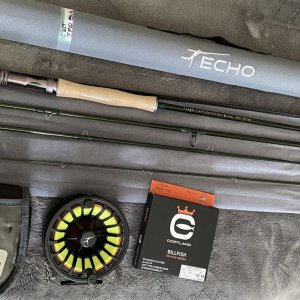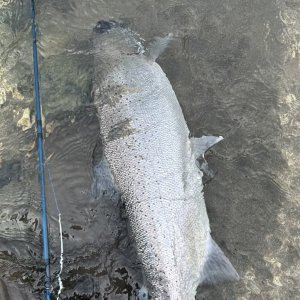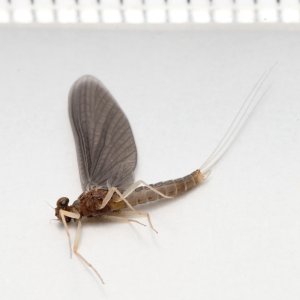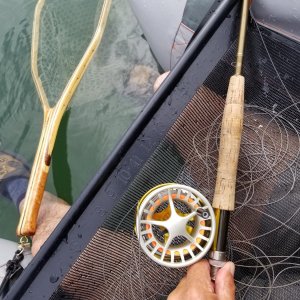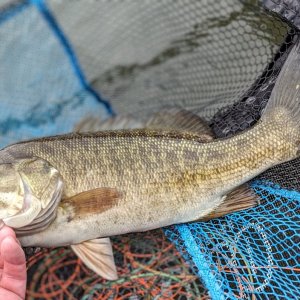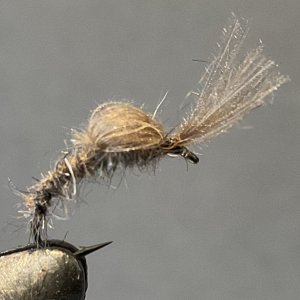Goldy was just trying to herd the fish to you. The least you could've done is supply a Milk Bone for his trouble.@Kfish doesn’t have a golden retriever which was the breed swimming laps around me while I was fishing…. but wait, quite a few other PNWFF members do have goldies.
SF
You are using an out of date browser. It may not display this or other websites correctly.
You should upgrade or use an alternative browser.
You should upgrade or use an alternative browser.
Puget Sound
- Thread starter Stonedfish
- Start date
I take my golden or my fly rod to the water, but never both and not the former when I think an angler might be around  . Brian, one surefire way to keep the goldens away would be to leave a nearly empty Styrofoam sand shrimp container several hundred yards away on an unproductive section of beach. Hopefully the owner won't let them actually snack, but it will definitely keep the pup focused on something besides you. I've only seen it work on the river, but I'm sure it would work on the beach too.
. Brian, one surefire way to keep the goldens away would be to leave a nearly empty Styrofoam sand shrimp container several hundred yards away on an unproductive section of beach. Hopefully the owner won't let them actually snack, but it will definitely keep the pup focused on something besides you. I've only seen it work on the river, but I'm sure it would work on the beach too. 
Or toss them an old dried up flounder like the one my dog got a hold of yesterday. Took several scoldings to finally drop itI take my golden or my fly rod to the water, but never both and not the former when I think an angler might be around. Brian, one surefire way to keep the goldens away would be to leave a nearly empty Styrofoam sand shrimp container several hundred yards away on an unproductive section of beach. Hopefully the owner won't let them actually snack, but it will definitely keep the pup focused on something besides you. I've only seen it work on the river, but I'm sure it would work on the beach too.

My dog loves the beach--lots of smelly stuff like that to roll in.Or toss them an old dried up flounder like the one my dog got a hold of yesterday. Took several scoldings to finally drop it
I take my golden or my fly rod to the water, but never both and not the former when I think an angler might be around. Brian, one surefire way to keep the goldens away would be to leave a nearly empty Styrofoam sand shrimp container several hundred yards away on an unproductive section of beach. Hopefully the owner won't let them actually snack, but it will definitely keep the pup focused on something besides you. I've only seen it work on the river, but I'm sure it would work on the beach too.

Andy,
Having owned a golden for 15 years, I can relate to this message.
If there was something stinky, she would find it and of course roll in it. She loved the water but had a disdain for getting a bath….
SF
So true about dogs rolling in "stink" - we had a black lab and lived a short hike from the Dungeness River, he knew where every rotting salmon carcass was along the river bank. We had an irrigation ditch that ran along the back side of our place - my brother and I got the duty to try and clean the dog in the ditch.Andy,
Having owned a golden for 15 years, I can relate to this message.
If there was something stinky, she would find it and of course roll in it. She loved the water but had a disdain for getting a bath….
SF
Pink Nighty
Life of the Party
Today I did not fish nor travel along Puget sound, but I did encounter one of its native citizens engaging in behavior we havent seen a ton of on here, especially at this time of year. A almost exclusively think of the Puget Sound Pumpkin as a marine critter, as that is where its always found. But of course they cannot spawn in the saltwater, and must return to their natal streams to spawn tomorrows gourds. Here i actually found one having given its last breath in the pursuit of existence for it's kind. Truly beautiful and humbling to witness.
@Wadin' Boot this was found in hamilton. Excellent spawning habitat for sure
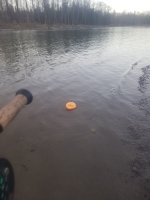
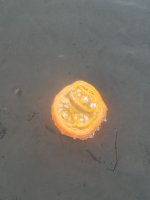
@Wadin' Boot this was found in hamilton. Excellent spawning habitat for sure


Today I did not fish nor travel along Puget sound, but I did encounter one of its native citizens engaging in behavior we havent seen a ton of on here, especially at this time of year. A almost exclusively think of the Puget Sound Pumpkin as a marine critter, as that is where its always found. But of course they cannot spawn in the saltwater, and must return to their natal streams to spawn tomorrows gourds. Here i actually found one having given its last breath in the pursuit of existence for it's kind. Truly beautiful and humbling to witness.
Frosty Half Pumpkin
Winter Steel, look up,
on the drift sorta floats an iced Fibonacci,
an ice hemisphere,
an orange torpor,
its seeds preserved in frozen matter.
The whole mess of it,
floatin' the final float
forever, friend
float on forever
you gourdeous orange thing
DimeBrite
Saltwater fly fisherman
The horseman's blade made quick work of that fiery orange gourd.Today I did not fish nor travel along Puget sound, but I did encounter one of its native citizens engaging in behavior we havent seen a ton of on here, especially at this time of year. A almost exclusively think of the Puget Sound Pumpkin as a marine critter, as that is where its always found. But of course they cannot spawn in the saltwater, and must return to their natal streams to spawn tomorrows gourds. Here i actually found one having given its last breath in the pursuit of existence for it's kind. Truly beautiful and humbling to witness.
@Wadin' Boot this was found in hamilton. Excellent spawning habitat for sure
View attachment 52063
View attachment 52065
DimeBrite
Saltwater fly fisherman
let your innards be saltedFrosty Half Pumpkin
Winter Steel, look up,
on the drift sorta floats an iced Fibonacci,
an ice hemisphere,
an orange torpor,
its seeds preserved in frozen matter.
The whole mess of it,
floatin' the final float
forever, friend
float on forever
you gourdeous orange thing
may you absorb Puget's brine
flaming carotenoids exalted
which upon the Dungeness dine
I always enjoy these discussions on our sea-run cutthroat. Especially folks' observations on what makes them tick and how we can fool them with our flies.
I can report here on a north Sound River while chasing bull trout I caught the first cutthroat kelts (2) of the year (1/20). The onset of spawning on those more southerly waters can not be too far off.
Something that I don't think gets enough attention is the effect of fishing pressure and how than may affect what flies they will take or even if they will chase our flies. If sharing a piece of water (even if several days earlier) with other anglers or even fishing behind myself, I nearly always do better by fishing something different than what I think they may have previously seen. I try not to fish the same piece of water more than once every two to three weeks and if I fish that water more frequently it is always with a different fly. While my experience is largely on the larger rivers my limit experience on the salt backs that observation up.
Something that have always surprised me in the rivers is how limited my success has been fishing egg or flesh patterns or even for that matter fishing immediately behind spawning salmon. Yes I have seen the cutts ramming the sides of spawning salmon and picking up loose eggs and have caught some cutthroat in that situation. Even though the vast majority of my cutthroat fishing has been in rivers from mid-August to well into the fall my best day egg/flesh patterns would not come close to making my top 100 days (using the more traditional spiders, streamers, attractor or insect patterns. I attribute that difference as another expression of the differences in behavior between north and south sound sea-runs.
Curt
I can report here on a north Sound River while chasing bull trout I caught the first cutthroat kelts (2) of the year (1/20). The onset of spawning on those more southerly waters can not be too far off.
Something that I don't think gets enough attention is the effect of fishing pressure and how than may affect what flies they will take or even if they will chase our flies. If sharing a piece of water (even if several days earlier) with other anglers or even fishing behind myself, I nearly always do better by fishing something different than what I think they may have previously seen. I try not to fish the same piece of water more than once every two to three weeks and if I fish that water more frequently it is always with a different fly. While my experience is largely on the larger rivers my limit experience on the salt backs that observation up.
Something that have always surprised me in the rivers is how limited my success has been fishing egg or flesh patterns or even for that matter fishing immediately behind spawning salmon. Yes I have seen the cutts ramming the sides of spawning salmon and picking up loose eggs and have caught some cutthroat in that situation. Even though the vast majority of my cutthroat fishing has been in rivers from mid-August to well into the fall my best day egg/flesh patterns would not come close to making my top 100 days (using the more traditional spiders, streamers, attractor or insect patterns. I attribute that difference as another expression of the differences in behavior between north and south sound sea-runs.
Curt
Divad
Whitefish
It is incredible the research (although limited) out there for these elusive things. Multiple failed study attempts at sein netting even led to the usage of an "angling team" of volunteers and WDFW. I'd agree with the changing of flies, and our south sound differences. I am not aware of too many estuaries north that still have chum carcasses in abundance. Not a type of pattern I ever would expect to read about for SRC but it is definitely in the observed literature. Need to make some Arrow Gobys and Staghorn Sculpin patterns too.I always enjoy these discussions on our sea-run cutthroat. Especially folks' observations on what makes them tick and how we can fool them with our flies.
I can report here on a north Sound River while chasing bull trout I caught the first cutthroat kelts (2) of the year (1/20). The onset of spawning on those more southerly waters can not be too far off.
Something that I don't think gets enough attention is the effect of fishing pressure and how than may affect what flies they will take or even if they will chase our flies. If sharing a piece of water (even if several days earlier) with other anglers or even fishing behind myself, I nearly always do better by fishing something different than what I think they may have previously seen. I try not to fish the same piece of water more than once every two to three weeks and if I fish that water more frequently it is always with a different fly. While my experience is largely on the larger rivers my limit experience on the salt backs that observation up.
Something that have always surprised me in the rivers is how limited my success has been fishing egg or flesh patterns or even for that matter fishing immediately behind spawning salmon. Yes I have seen the cutts ramming the sides of spawning salmon and picking up loose eggs and have caught some cutthroat in that situation. Even though the vast majority of my cutthroat fishing has been in rivers from mid-August to well into the fall my best day egg/flesh patterns would not come close to making my top 100 days (using the more traditional spiders, streamers, attractor or insect patterns. I attribute that difference as another expression of the differences in behavior between north and south sound sea-runs.
Curt
It does look like spawning at least in that research was grouped into two distinct categories of cutts, Dec/Jan and Feb/Mar+. With larger systems having fall be a factor and even summer for larger/further watersheds. But small streams like found in the SS shared the correlation found of small streams = late groups. And of course, room for a lot of further research to definitively say much.
I greatly look forward to how the 1 mile of watershed opened up by the Capitol Lake removal changes things!
That's just how the pumpkin bios mark the squash they've already counted in their pumpkin spawner surverys.The horseman's blade made quick work of that fiery orange gourd.
It is incredible the research (although limited) out there for these elusive things. Multiple failed study attempts at sein netting even led to the usage of an "angling team" of volunteers and WDFW. I'd agree with the changing of flies, and our south sound differences. I am not aware of too many estuaries north that still have chum carcasses in abundance. Not a type of pattern I ever would expect to read about for SRC but it is definitely in the observed literature. Need to make some Arrow Gobys and Staghorn Sculpin patterns too.
It does look like spawning at least in that research was grouped into two distinct categories of cutts, Dec/Jan and Feb/Mar+. With larger systems having fall be a factor and even summer for larger/further watersheds. But small streams like found in the SS shared the correlation found of small streams = late groups. And of course, room for a lot of further research to definitively say much.
I greatly look forward to how the 1 mile of watershed opened up by the Capitol Lake removal changes things!
Besides digging around in oysters and barnacles for meals and getting their faces scraped up, how cool would it be if someone could get on film a searun cutt eating the neck off a clam.
Raw clam necks aren’t the most tender delicate things ( kind of rubbery) and cutts don’t have huge teeth. I wonder if that is a one bite operation for a cutt or multiple yanks with maybe some tearing spins?
SF
As I also enjoy clam necks I would welcome the chance to help fund a study of this oft cited phenomenon, maybe pick up a few tips.Besides digging around in oysters and barnacles for meals and getting their faces scraped up, how cool would it be if someone could get on film a searun cutt eating the neck off a clam.
Raw clam necks aren’t the most tender delicate things ( kind of rubbery) and cutts don’t have huge teeth. I wonder if that is a one bite operation for a cutt or multiple yanks with maybe some tearing spins?
SF
As I also enjoy clam necks I would welcome the chance to help fund a study of this oft cited phenomenon, maybe pick up a few tips.
Time to write a grant. Maybe Ivar’s can do the research.
SF
Divad
Whitefish
Split 2.5hrs between two beaches today at low tide. At the first I found loads of 12-15in residents loving the slow stripped shrimp pattern.
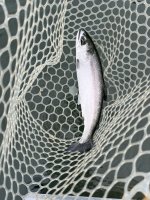
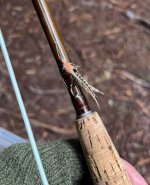
At the second beach I watched one fish rise and did my best on predicting his movement. As my next cast was about to land he rose under it. Didn’t see him again
I figured I’d try the slacker water inside the cove. Saw one rise at a distance but by the time I got there, rocks were being thrown. As expected it’s Sunday, glad people are getting their kids out.
Found these in the shallower water of the cove, they were 1cm long and thousands of them.
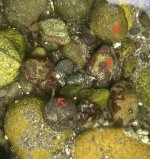
A small creek feeds the cove so I decided to see who was calling it home.
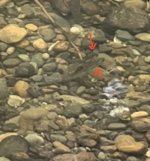
Little 1-2in fish. Darker color with some obvious contrasting along the side. (Stills from video, excuse the resolution). A few of these guys were about the creek.


At the second beach I watched one fish rise and did my best on predicting his movement. As my next cast was about to land he rose under it. Didn’t see him again
I figured I’d try the slacker water inside the cove. Saw one rise at a distance but by the time I got there, rocks were being thrown. As expected it’s Sunday, glad people are getting their kids out.
Found these in the shallower water of the cove, they were 1cm long and thousands of them.

A small creek feeds the cove so I decided to see who was calling it home.

Little 1-2in fish. Darker color with some obvious contrasting along the side. (Stills from video, excuse the resolution). A few of these guys were about the creek.
Last edited:
I'd be smoking' them resi....umm.
Those shrimp-like creatures are mysids (aka opossum shrimp). There are at least 28 marine species in the PNW (and freshwater species too such as Neomysis mercedes). They are actually more closely to related to amphipods and isopods (Peracarida) than they are to shrimp and crabs (Decapoda). Peracaridian crustaceans lack a larval stage. The females retain fertilized eggs in a brood punch under their thorax, a marsupium. The fertilized young complete their development within the marsupium and emerge as juveniles = miniature adults. While at least one local mysid species, Archeomysis grebnitkii, burrows right in the surf zone along sandy beaches, other species form schools that swim using their thoracic appendages in the nearshore environment. While diving off the west side of San Juan Island, I have encountered schools so thick that you could not see the rock walls behind them. Most species are opportunistic omnivores and are capable of filter feeding on fine particles, such as diatoms.Split 2.5hrs between two beaches today at low tide. At the first I found loads of 12-15in residents loving the slow stripped shrimp pattern.
Found these in the shallower water of the cove, they were 1cm long and thousands of them.
View attachment 52953
Steve
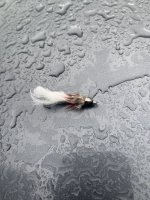
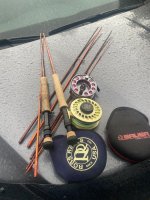
Had a decent day and tested out lines. Or combo lines. The Bolt is a helluva a rod IMHO. I have issues tho. Guide size is not great on the rod. Why they went 5 weight on the Bolt 7 weight for guide size ….hmm. 12-10 strip guide size instead of usual 16-12, or even bigger like some dedicated salt rods. Worried about an 1/8 ounce or so I guess ?

